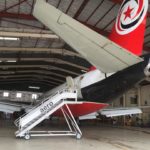
In order to further secure Nigeria’s airspace and be able to identify every aircraft flying in any part of the country, the federal government has moved to complete the Wider Area Mulitlateration project, which is aimed at identifying low flying aircraft, which include single engine equipment, helicopters and others. Wide Area Multilateration (WAM) is a surveillance technology that works by employing multiple small remote sensors throughout an area to compensate for terrain obstruction, which enables air traffic controllers to apply more efficient separation standards for the aircraft operating in the affected airspace.
The objective of the federal government in completing the project is to enable air traffic controllers identify aircraft flying below the radar or cannot be captured by the Total Radar Coverage of Nigeria (TRACON). There are reports that indicate that unauthorised aircraft may have been operating in Nigeria’s airspace below the height that could be captured by the radar. Although these reports have not been confirmed, but the federal government has intensified effort to complete the WAM project in order to have comprehensive identification of every aircraft in the airspace no matter the height of the aircraft. This was confirmed by the Managing Director of the Nigerian Airspace Management Agency (NAMA), Captain Fola Akinkuotu, who told THISDAY that when completed the equipment would capture all the low flying aircraft that have activated and correspondent transponders in the airspace. He said the major objectives of the project are to communicate to these aircraft while airborne and also to monitor movement of aircraft in the airspace, which is part of security checks. “We are installing Wide Area Multilateration in the old eastern region (including South South and South Eastern part of the country) and later we will extend the project to all parts of the country. The installation is being done right now in these areas and we are hoping that the project will be completed before the end of this year after we have acquired the site for installation,” Akinkuotu said. He explained that acquiring the site involves dealing with third parties that must provide support for the project. The sites are the locations where the equipment would be mounted and it is expected that the sites would be fortified and protected. THISDAY learnt that the project would provide service to oil and gas flight services, helicopter shuttles and aircraft oil and gas crew movements in the Niger Delta area, where the mangrove and seaside terrain need special attention. “We have to acquire the site.
Acquiring the site involves dealing with third parties. We have to mount the equipment, which requires cooperation with the host communities. The area must be protected,” the NAMA boss said. He said the project would cost huge amount of money but the gain is that anything that operates at low level would be captured and this would provide safety net for aircraft operating in the littoral regions. “It will provide directional guidance and help in aircraft separation. The primary target really is for air traffic management but it is also like any other surveillance system, it can also be used to provide safety and security,” he said. By providing navigation, surveillance and communication services, NAMA effectively manages Nigeria’s airspace and ensures that aircraft movement is safe. THISDAY learnt that what initially prompted the WAM project was to ensure that there is effective communication between air traffic control and aircraft providing shuttle services to the oil and gas industry. But with the current security situation in the country, efforts were intensified to ensure that the project was completed.






